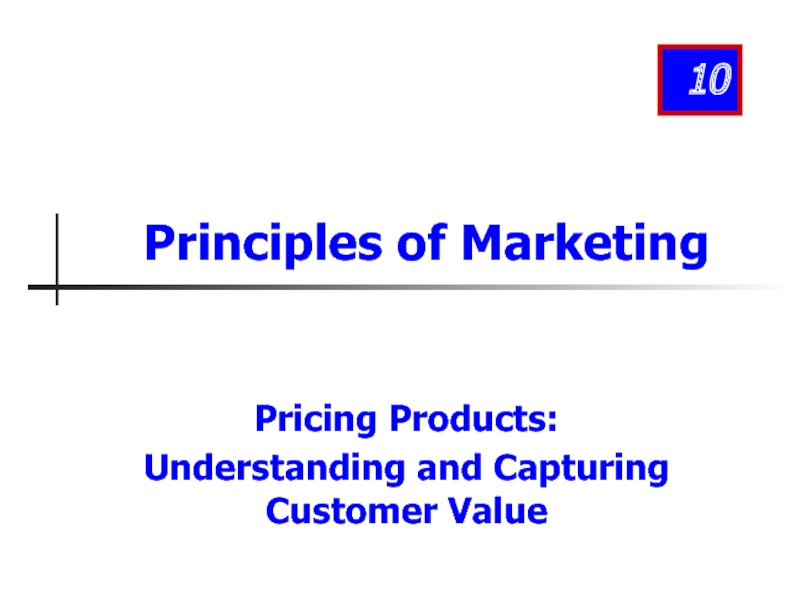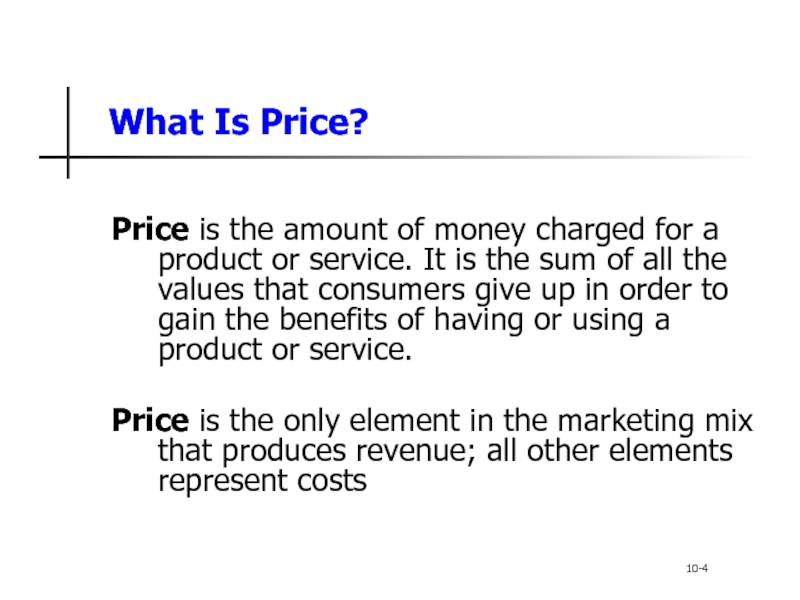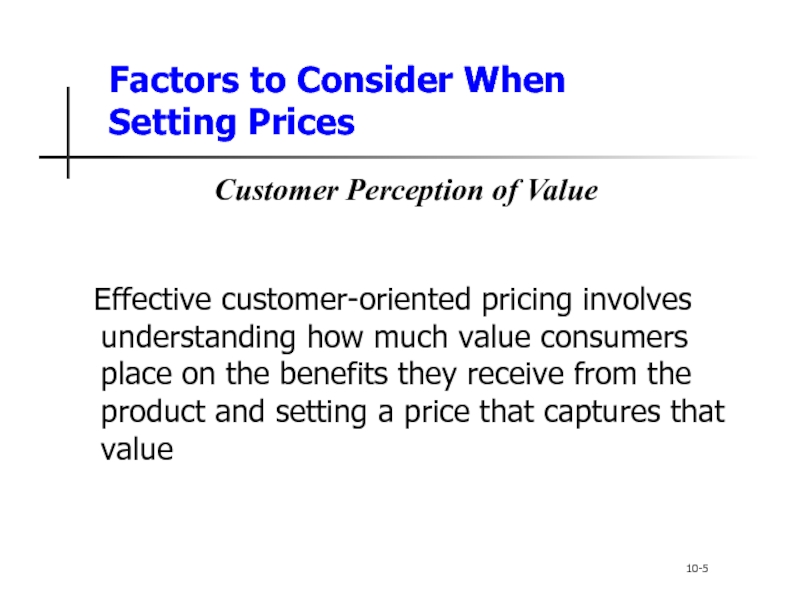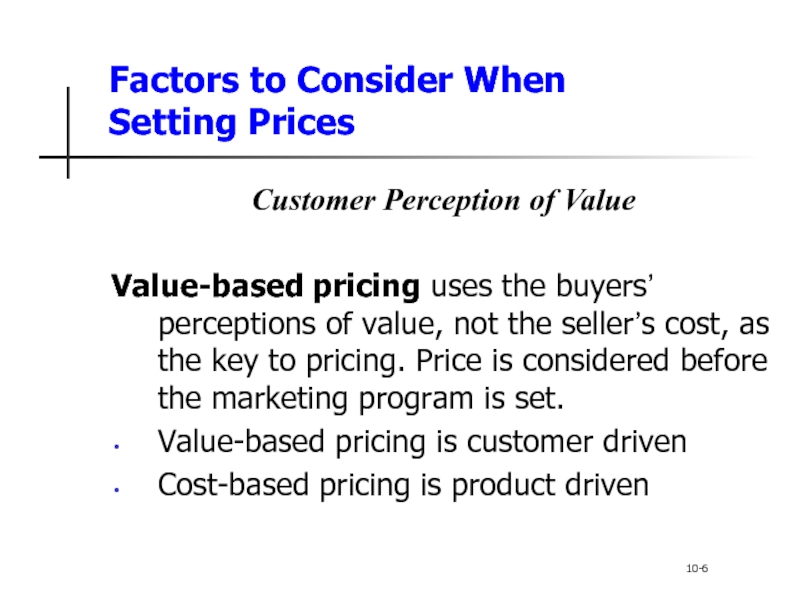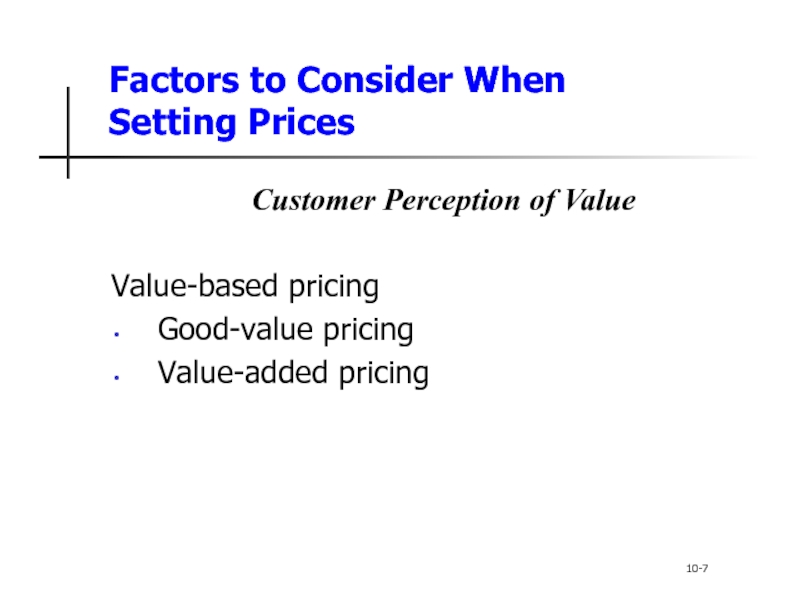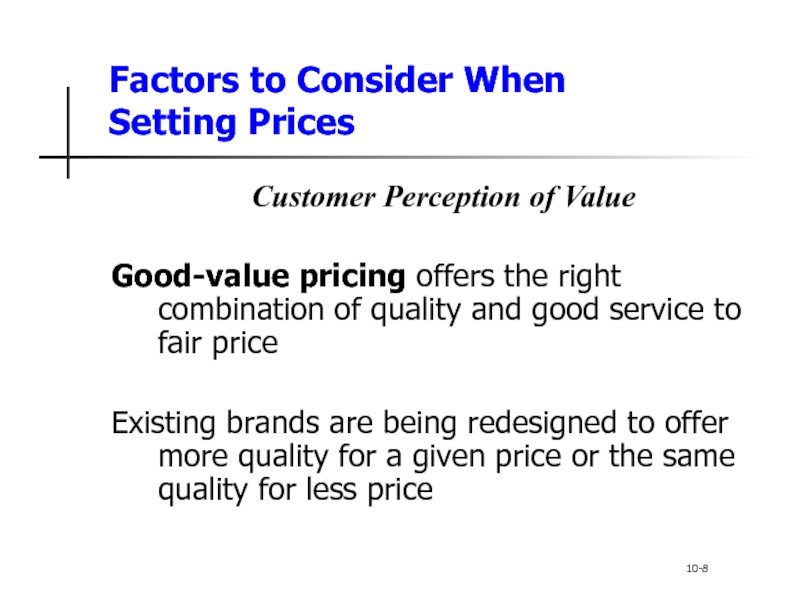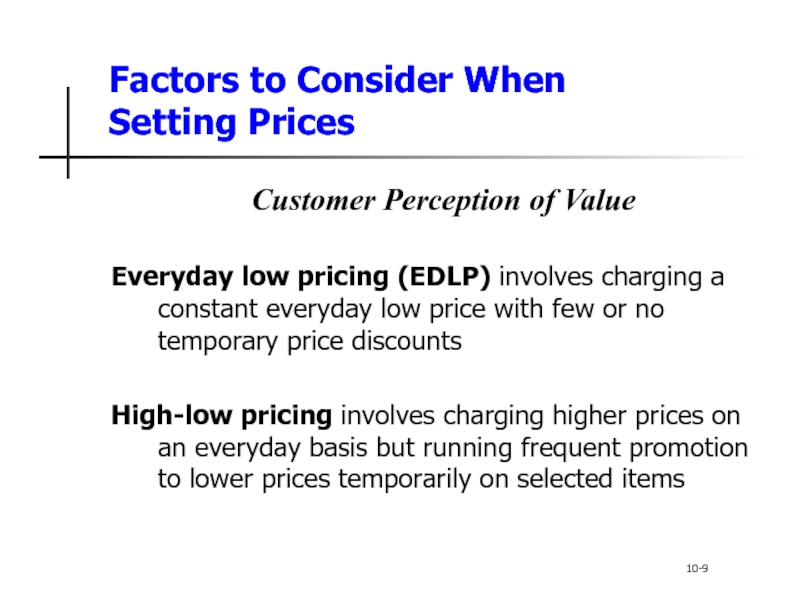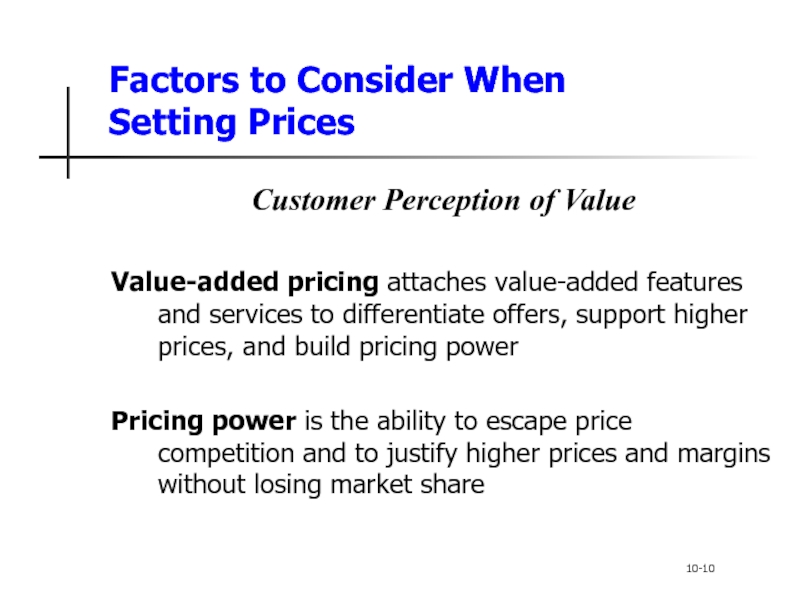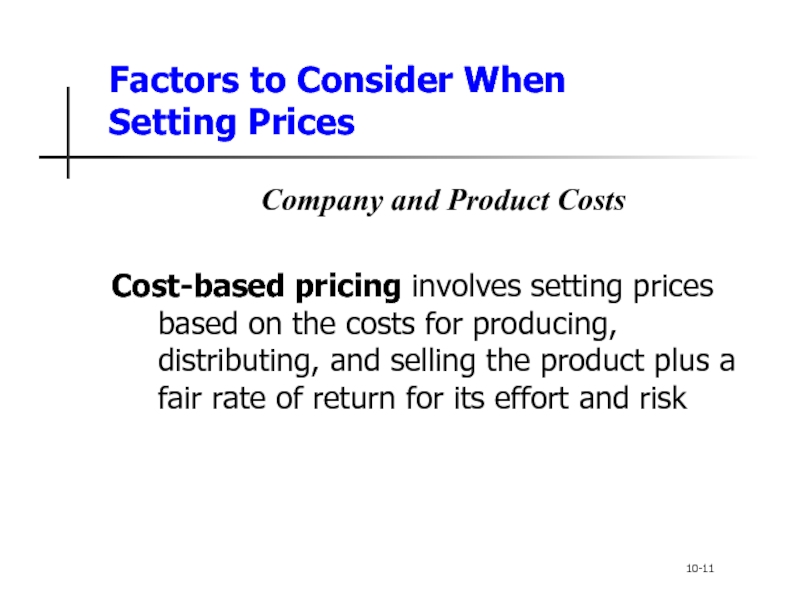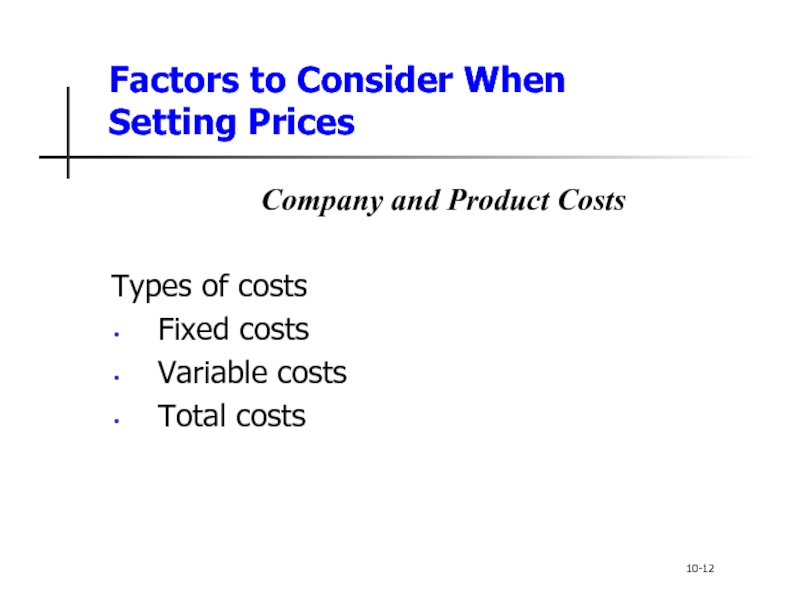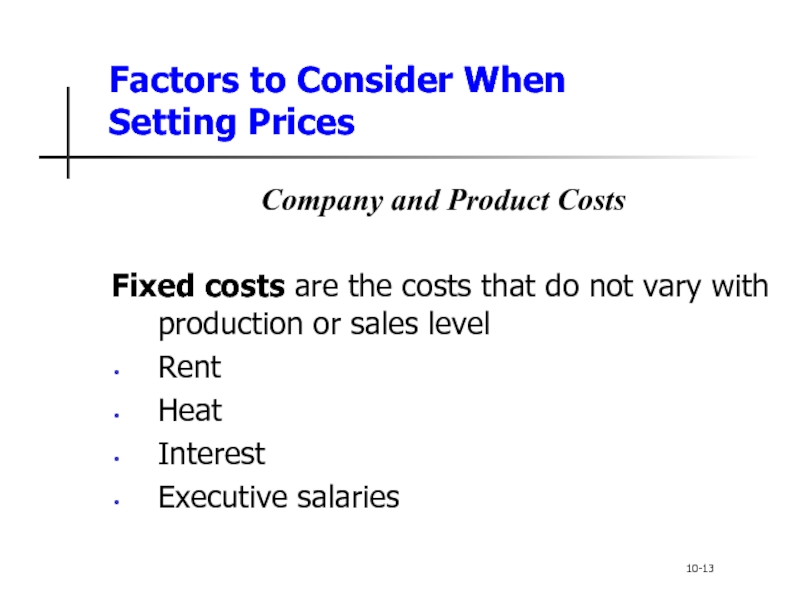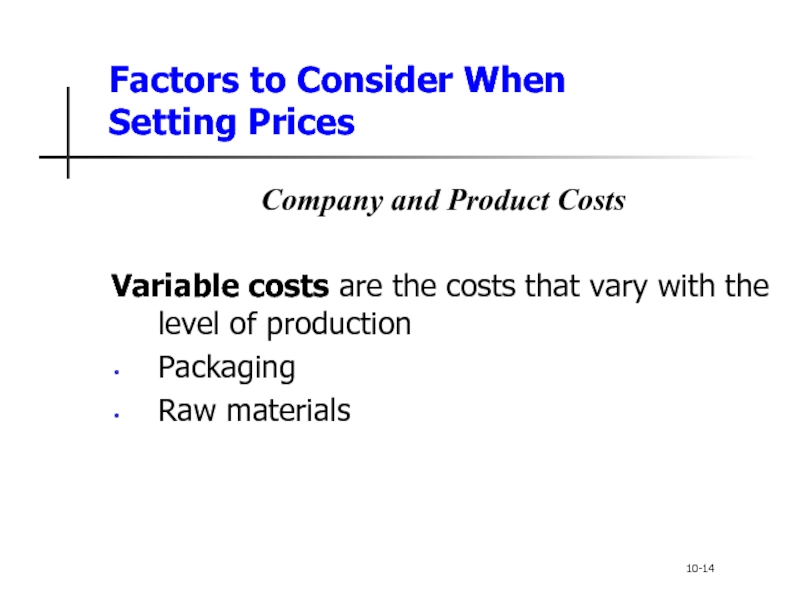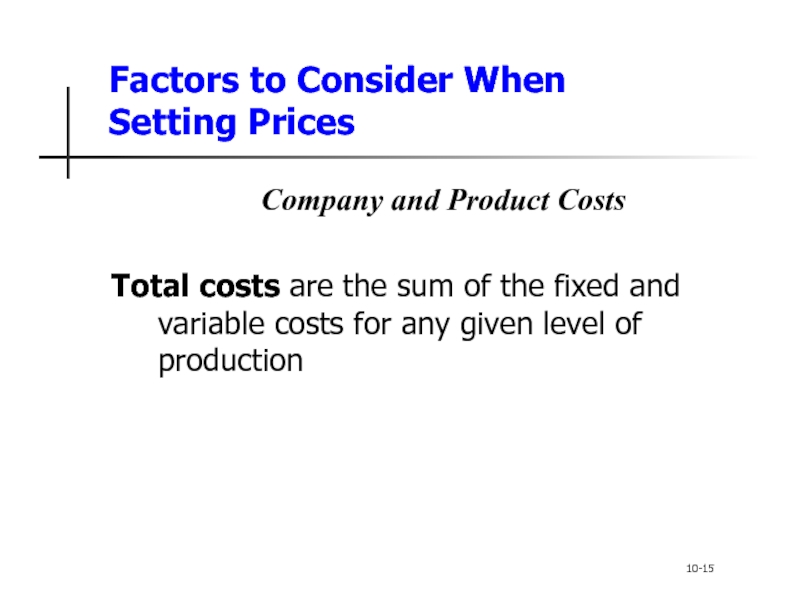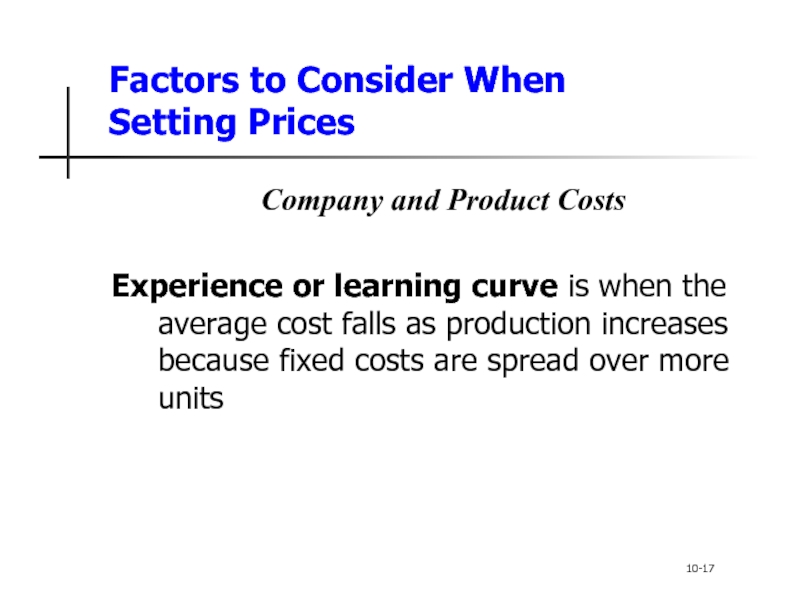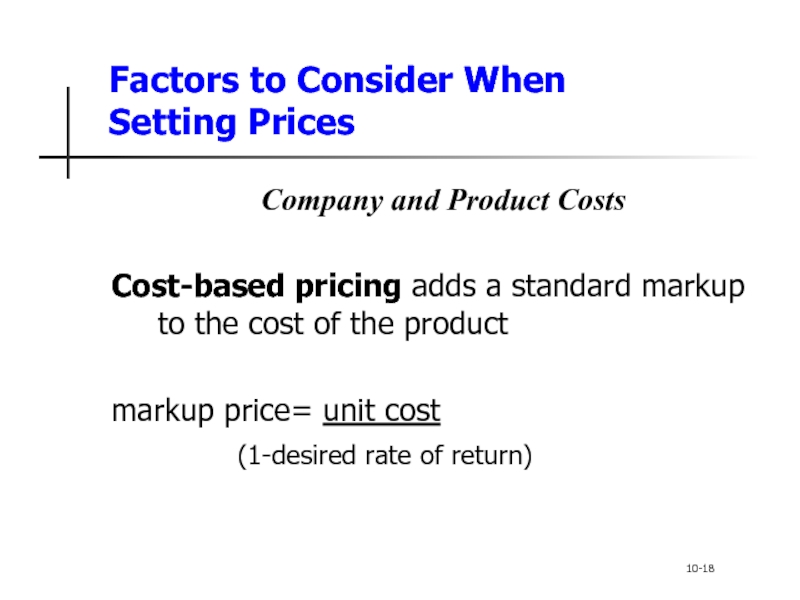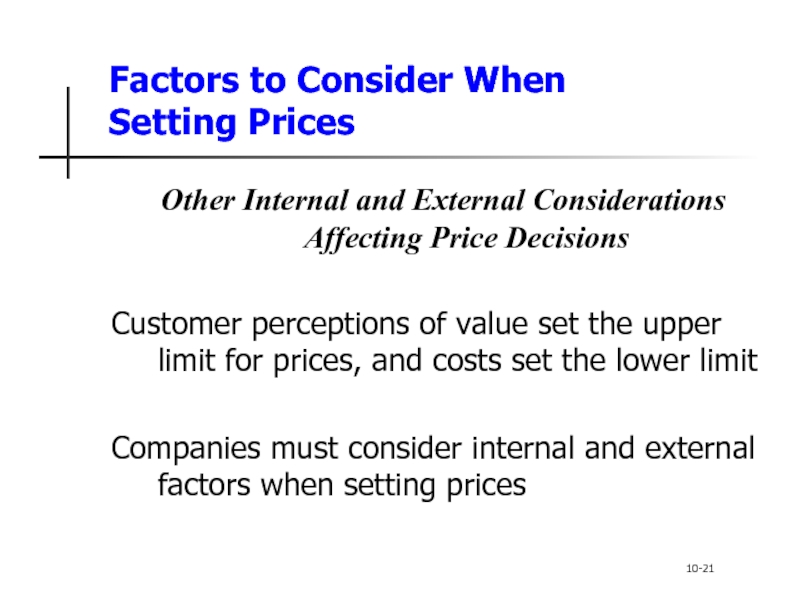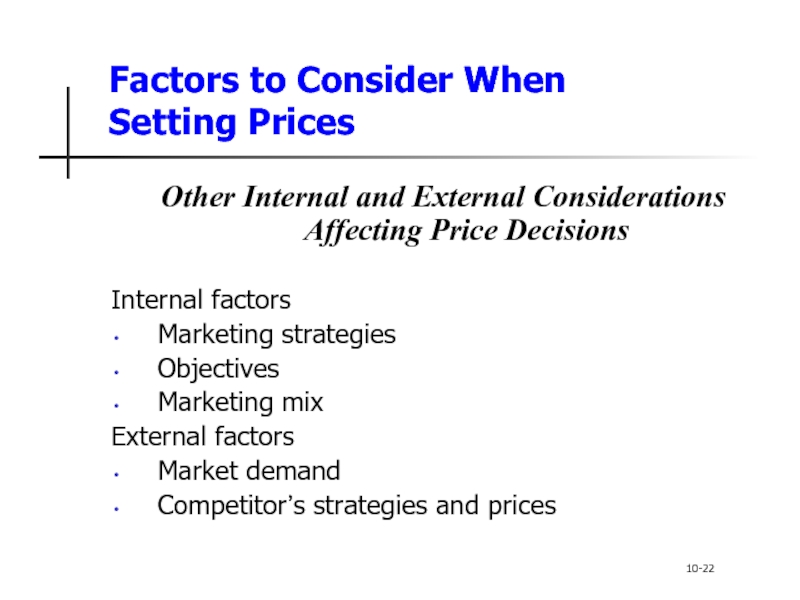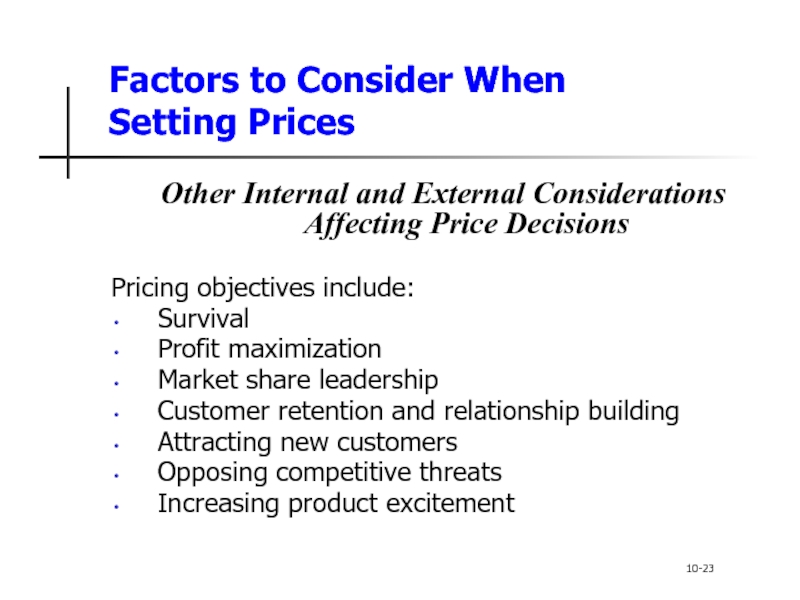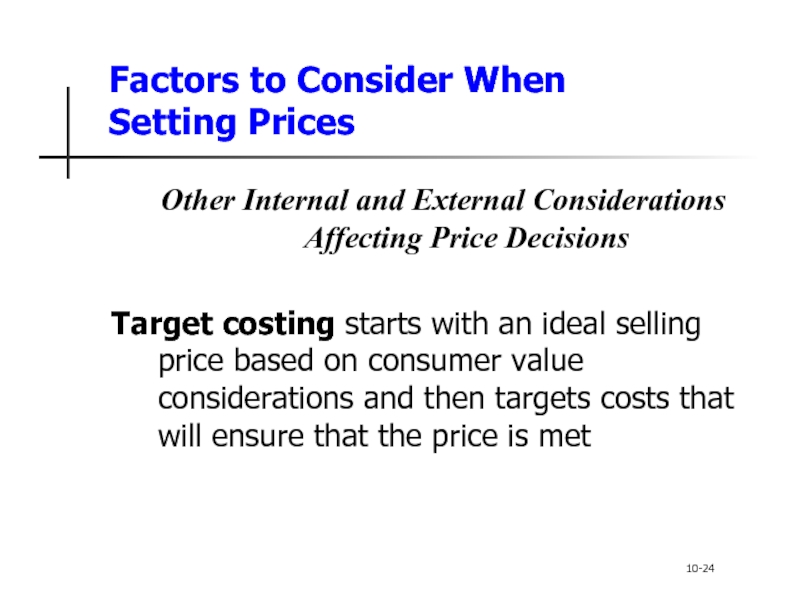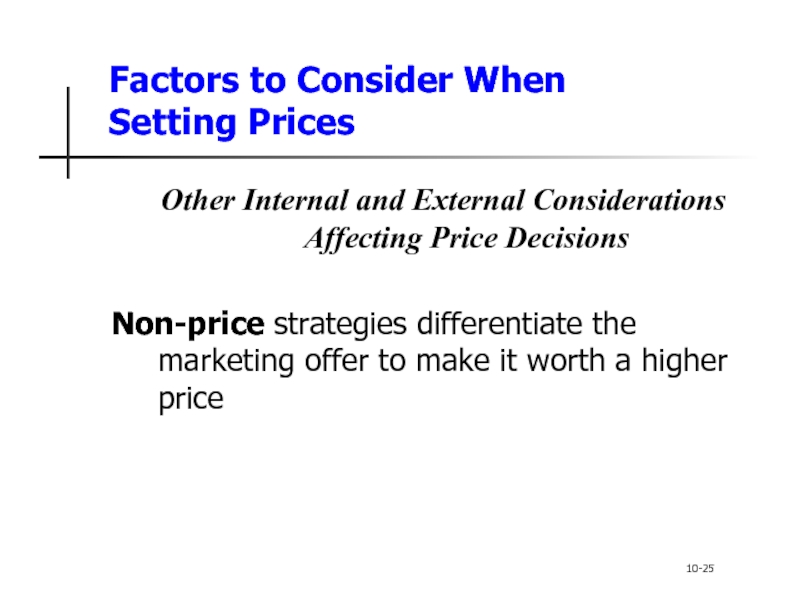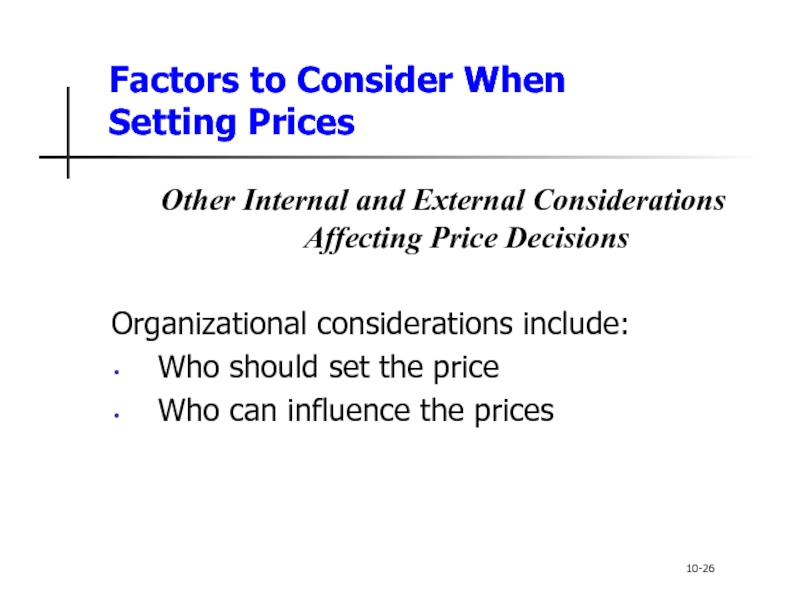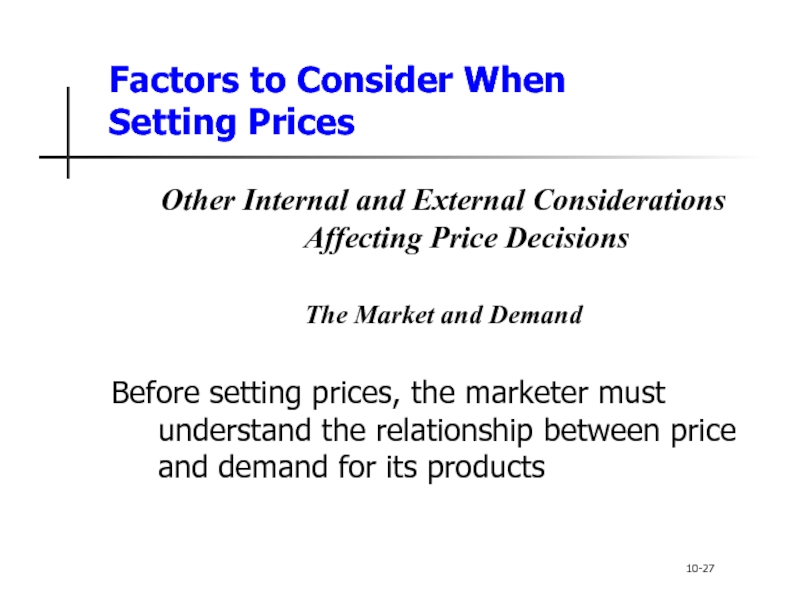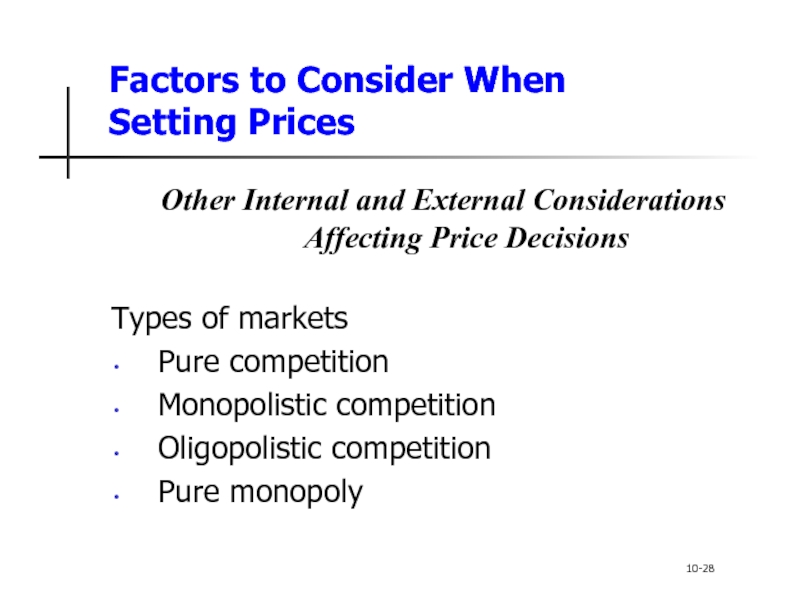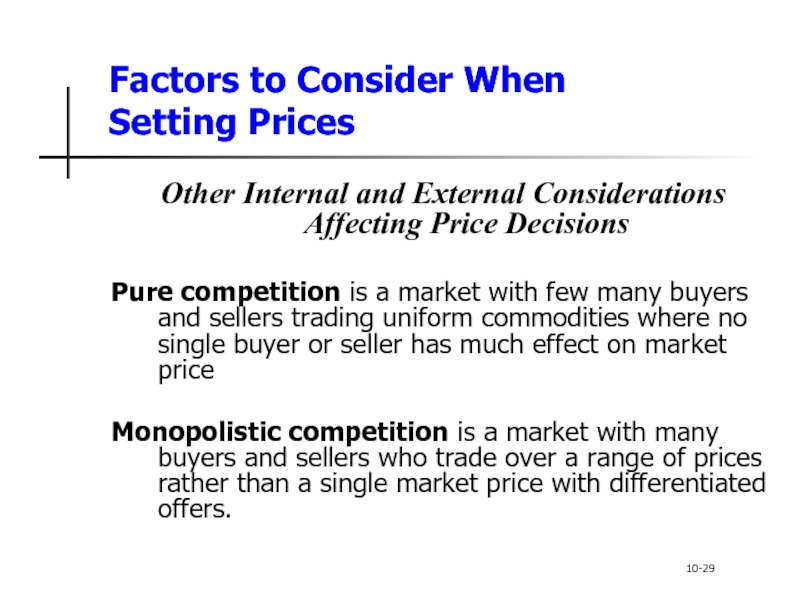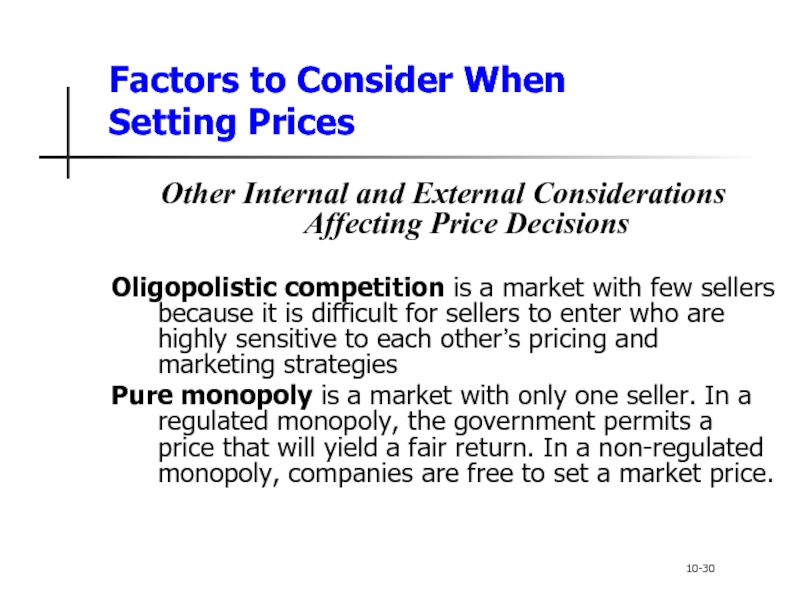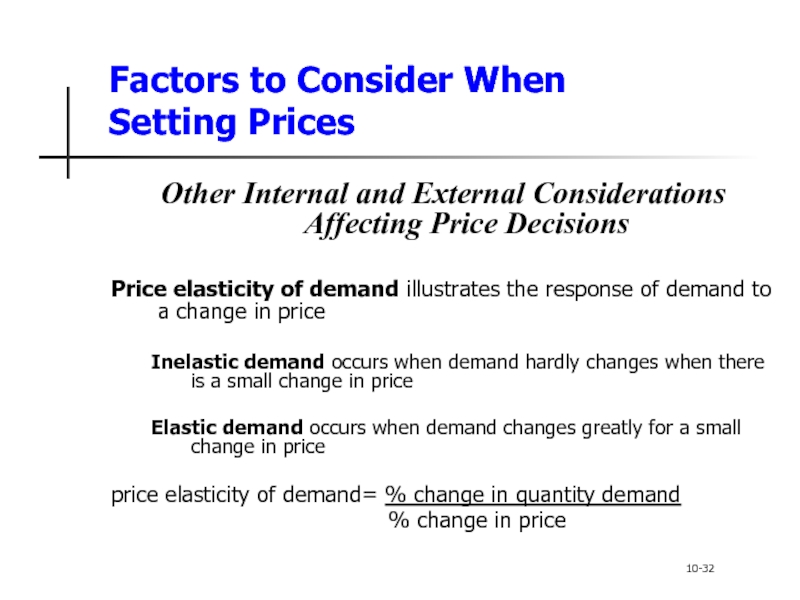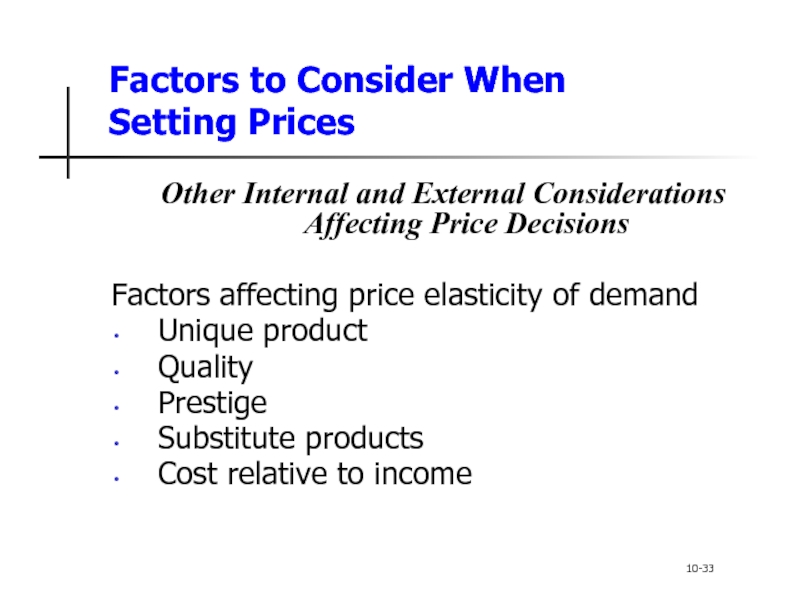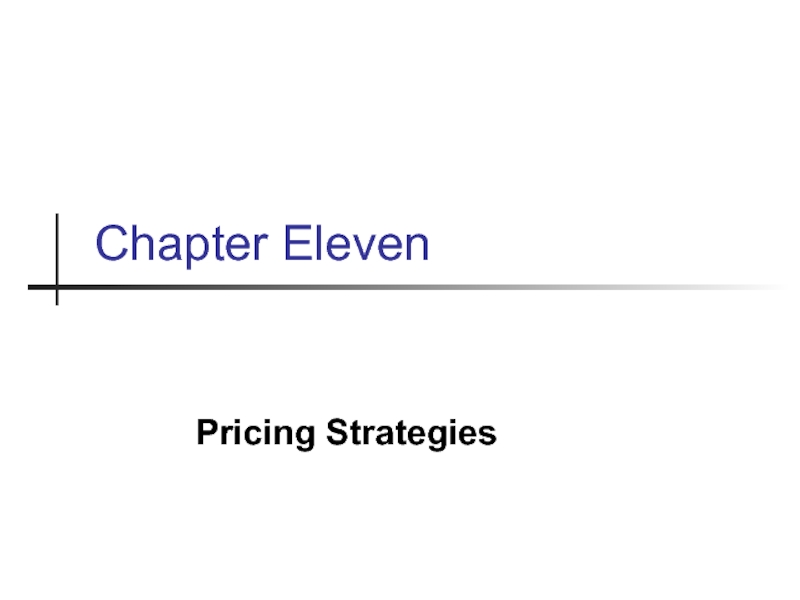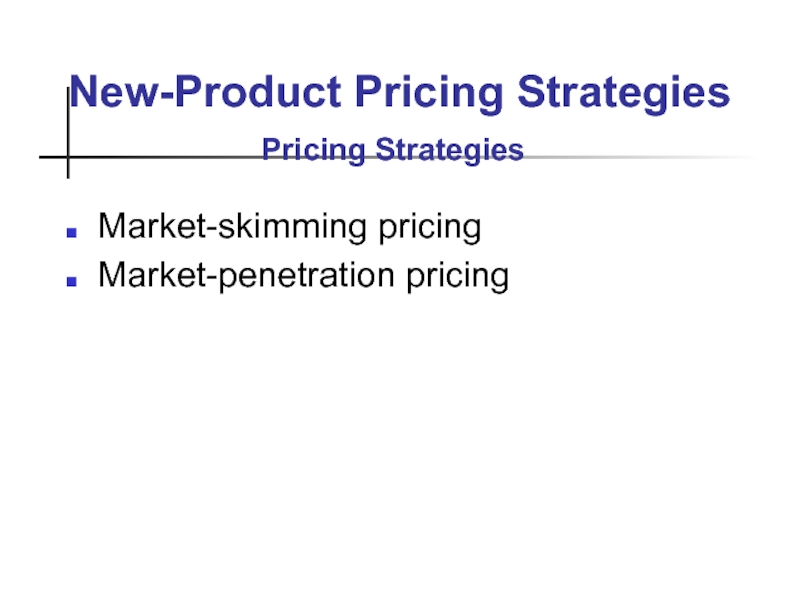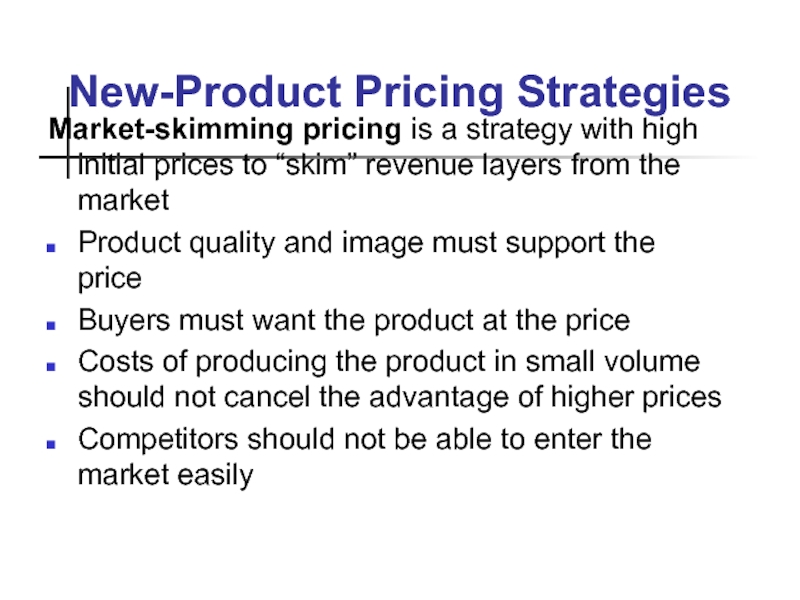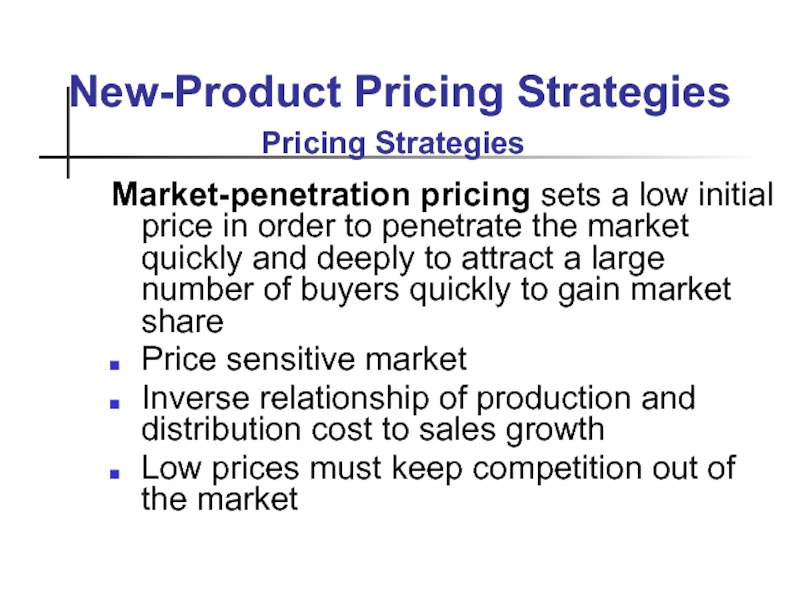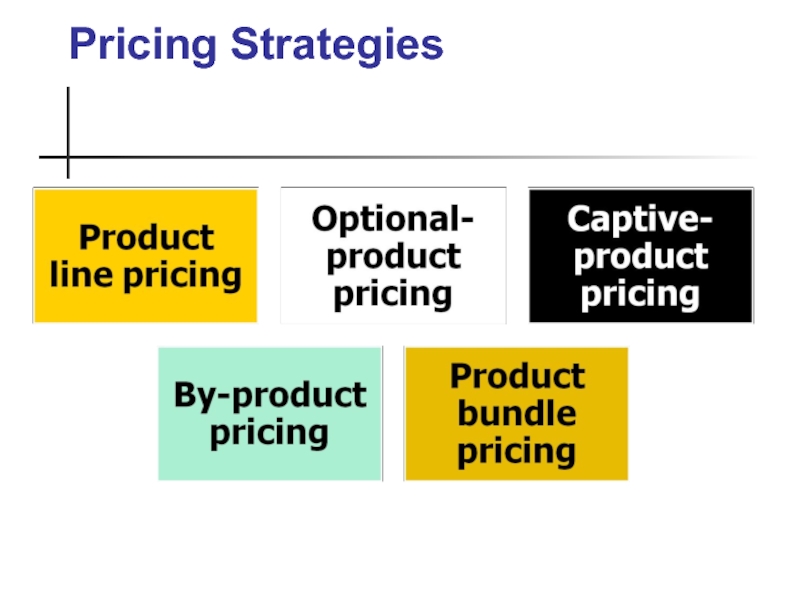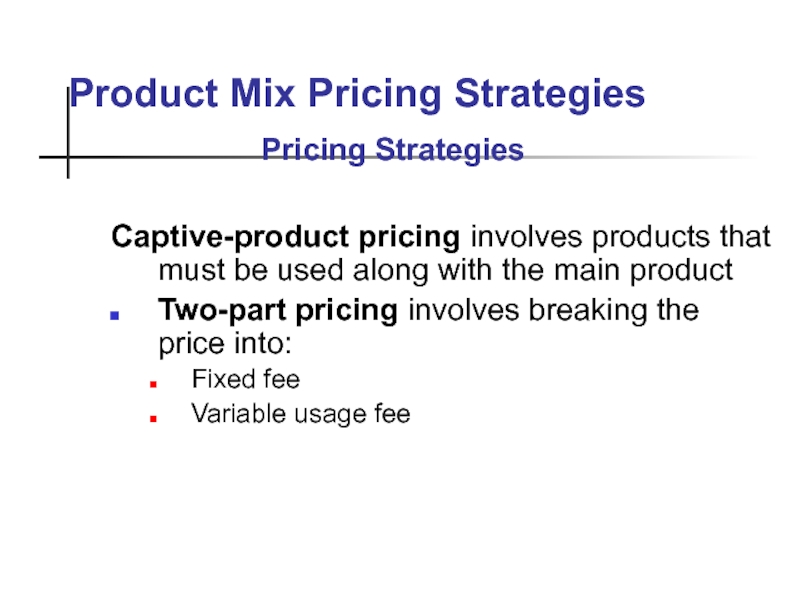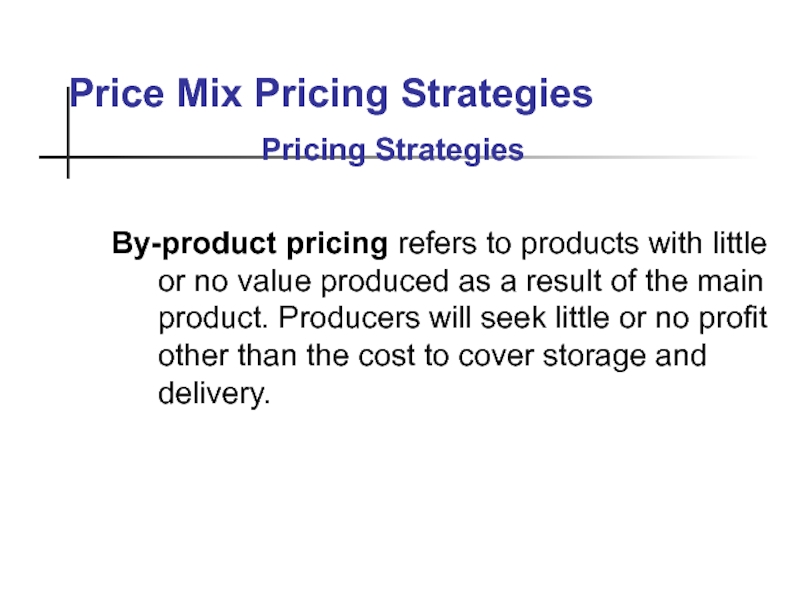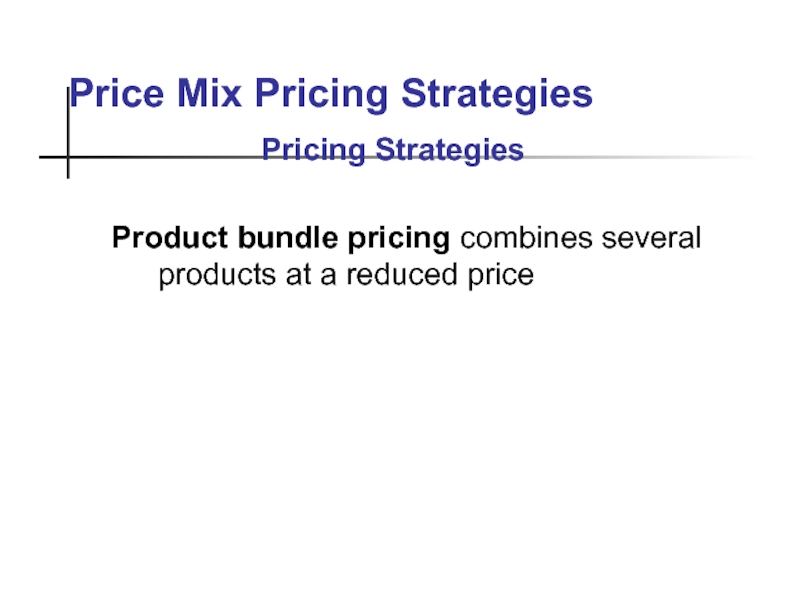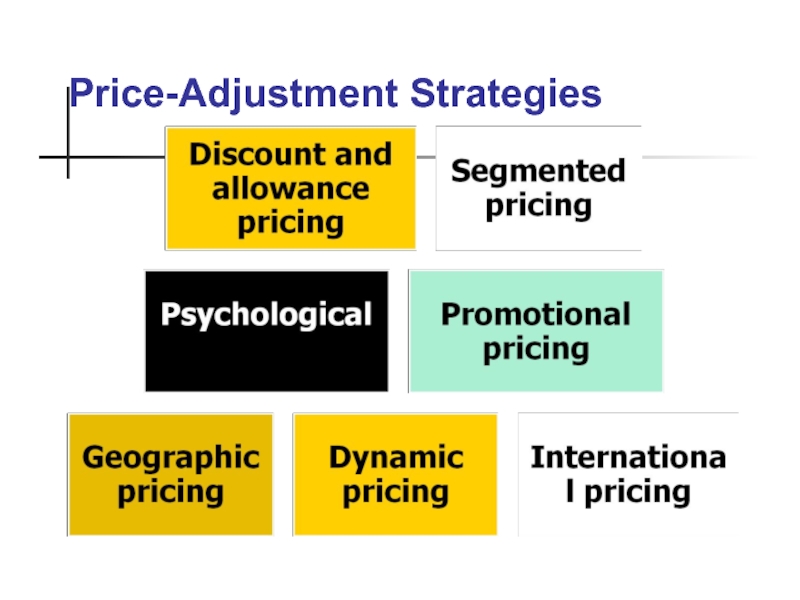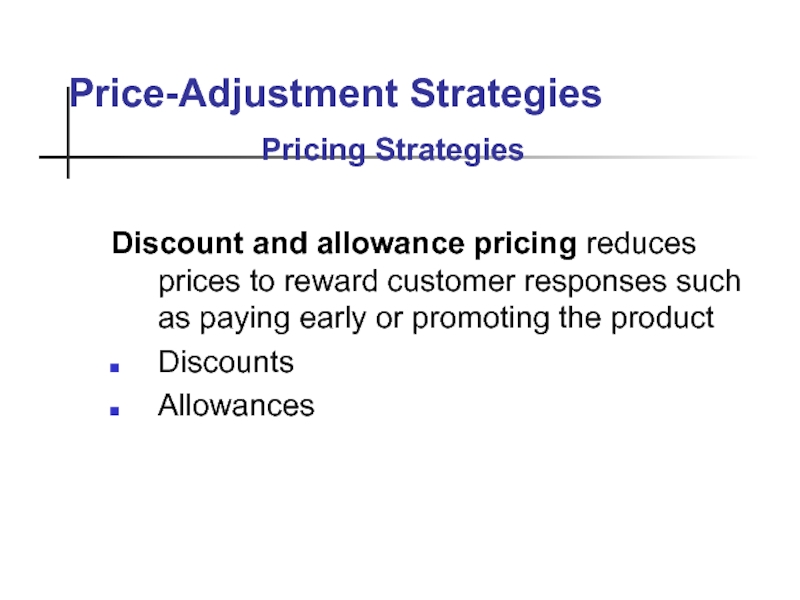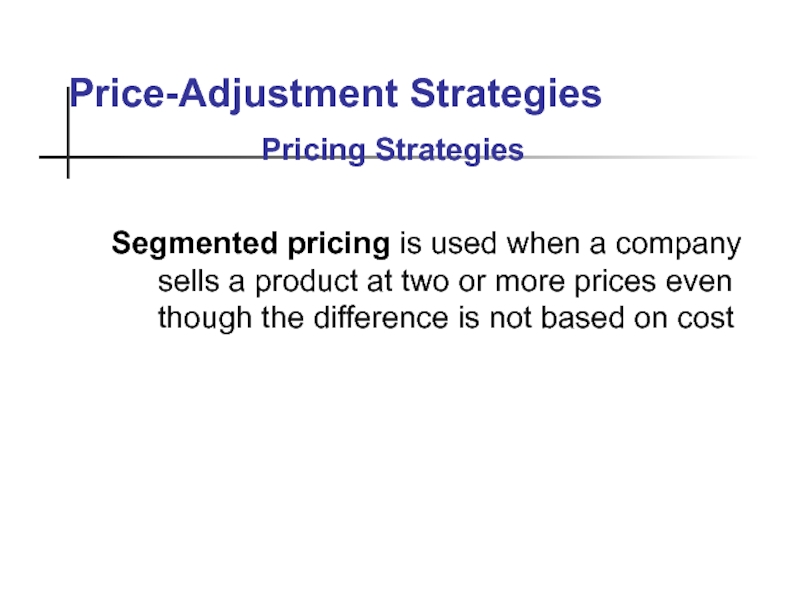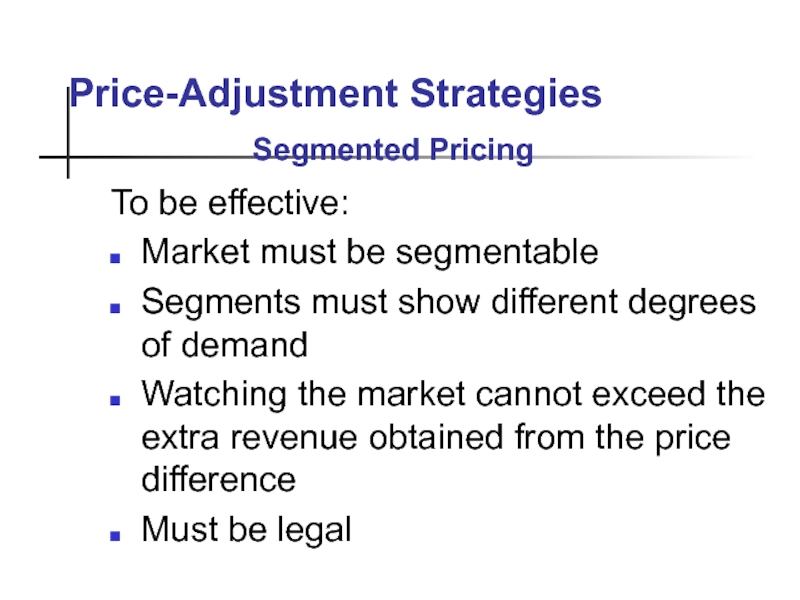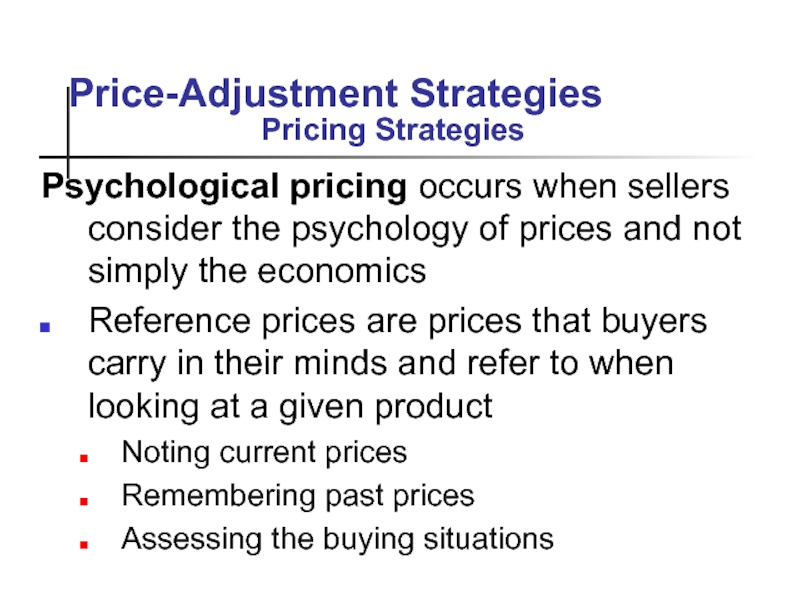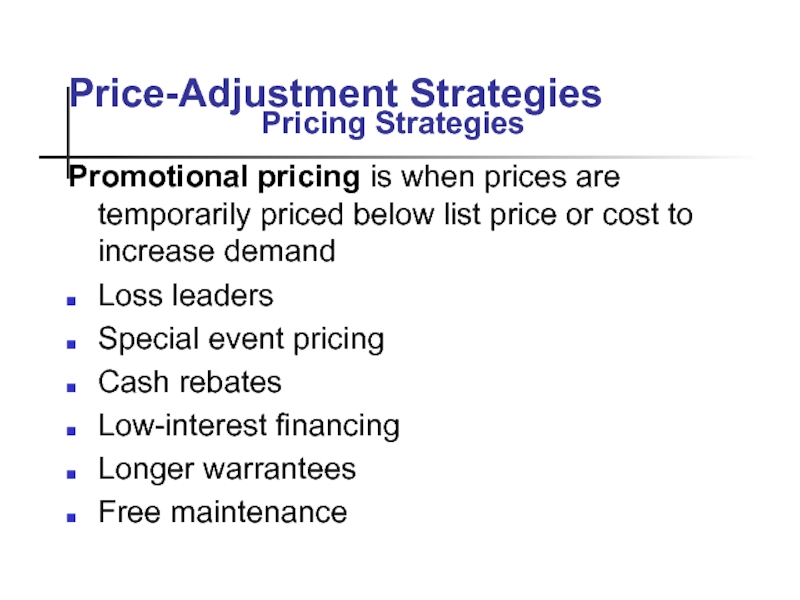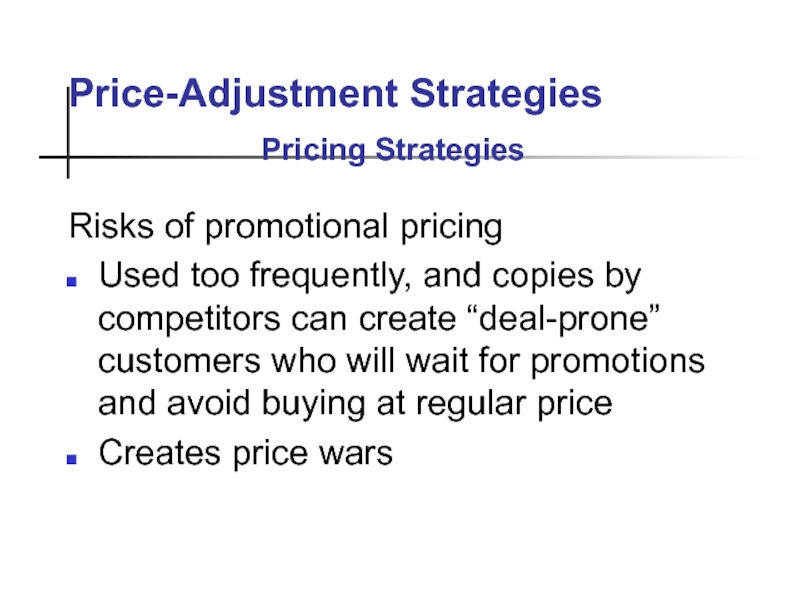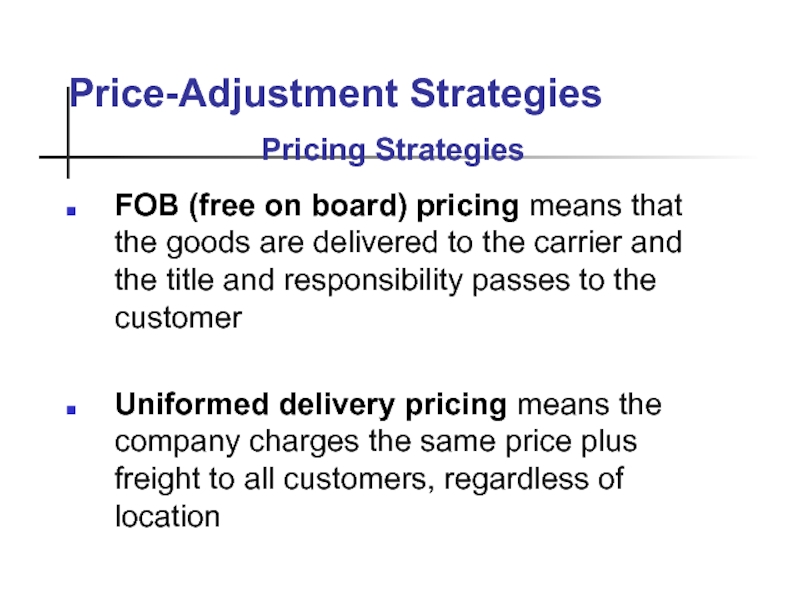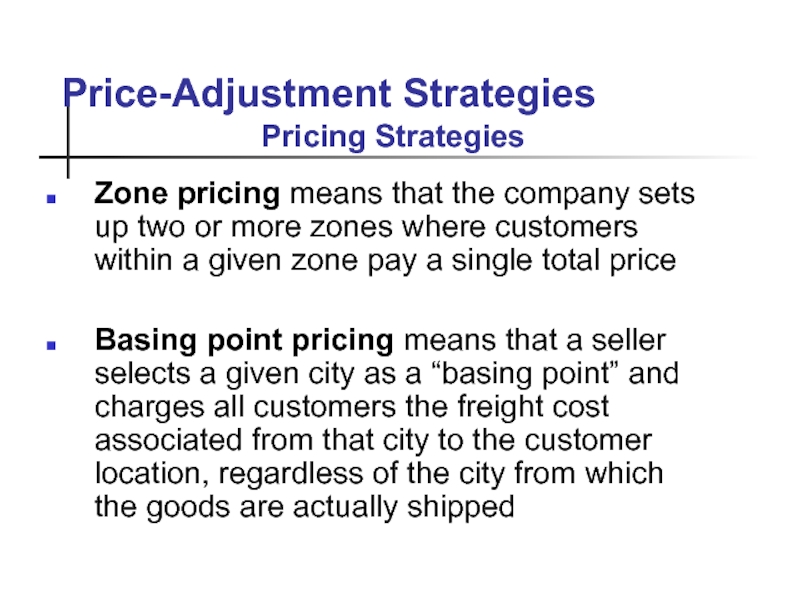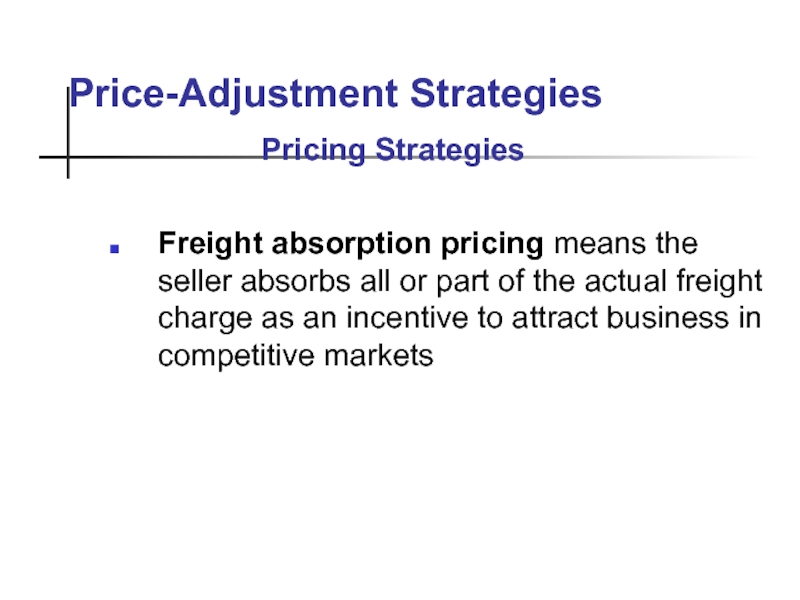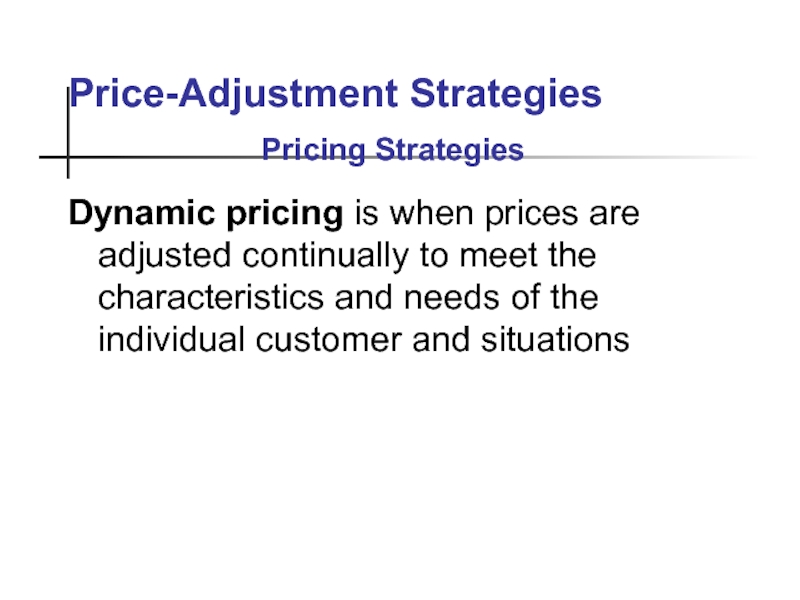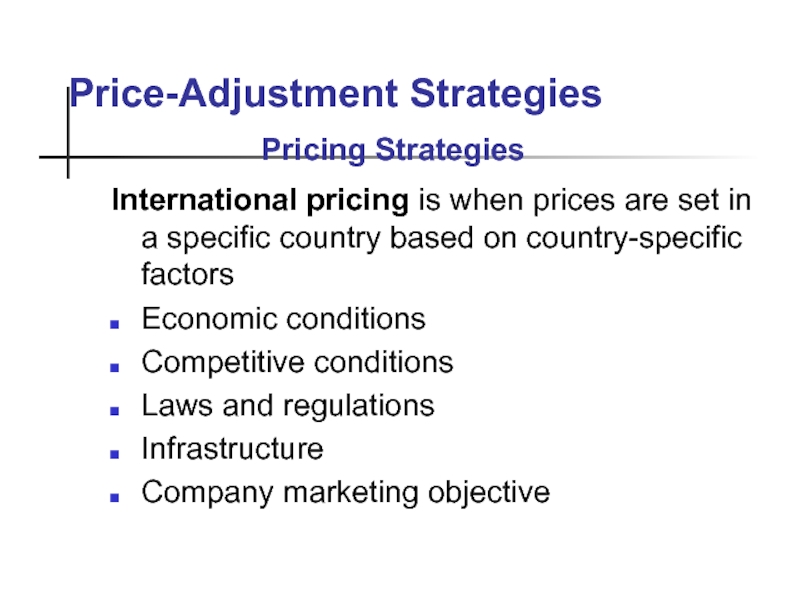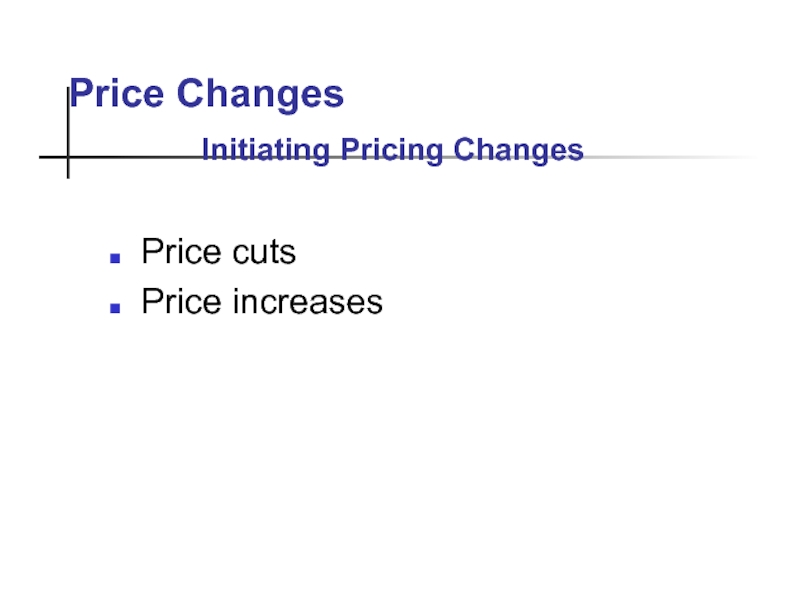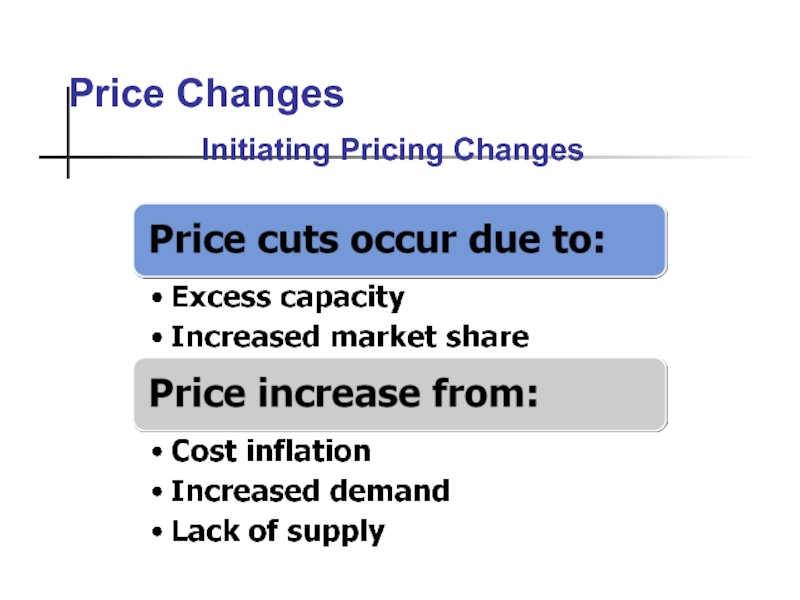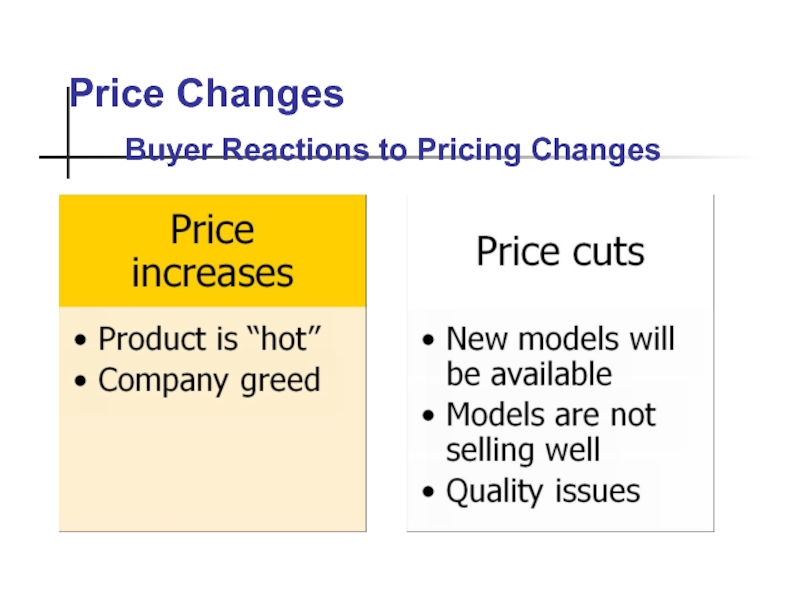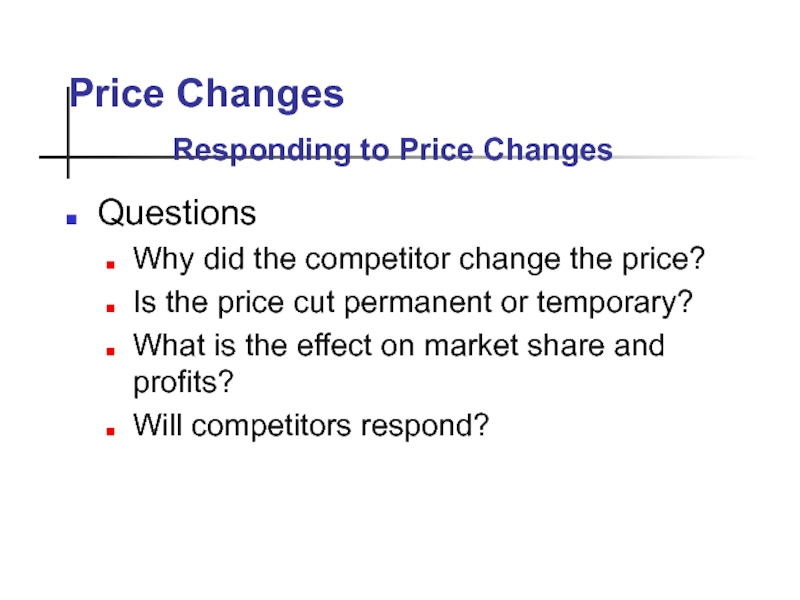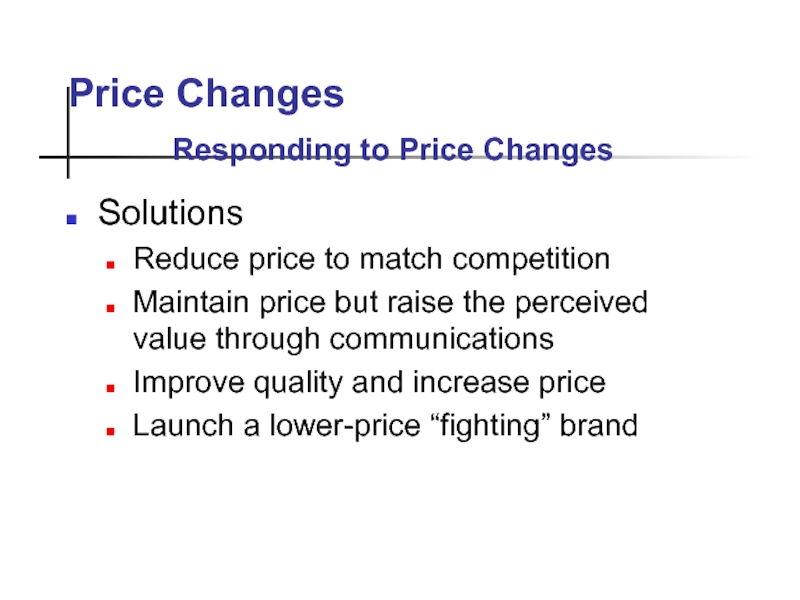- Главная
- Разное
- Дизайн
- Бизнес и предпринимательство
- Аналитика
- Образование
- Развлечения
- Красота и здоровье
- Финансы
- Государство
- Путешествия
- Спорт
- Недвижимость
- Армия
- Графика
- Культурология
- Еда и кулинария
- Лингвистика
- Английский язык
- Астрономия
- Алгебра
- Биология
- География
- Детские презентации
- Информатика
- История
- Литература
- Маркетинг
- Математика
- Медицина
- Менеджмент
- Музыка
- МХК
- Немецкий язык
- ОБЖ
- Обществознание
- Окружающий мир
- Педагогика
- Русский язык
- Технология
- Физика
- Философия
- Химия
- Шаблоны, картинки для презентаций
- Экология
- Экономика
- Юриспруденция
Principles of Marketing презентация
Содержание
- 1. Principles of Marketing
- 2. What Is Price? Price is
- 3. Factors to Consider When
- 4. Factors to Consider When
- 5. Factors to Consider When
- 6. Factors to Consider When
- 7. Factors to Consider When
- 8. Factors to Consider When
- 9. Factors to Consider When
- 10. Factors to Consider When
- 11. Factors to Consider When
- 12. Factors to Consider When
- 13. Factors to Consider When
- 14. Factors to Consider When
- 15. Factors to Consider When
- 16. Factors to Consider When
- 17. Factors to Consider When
- 18. Factors to Consider When
- 19. Factors to Consider When
- 20. Factors to Consider When
- 21. Factors to Consider When
- 22. Factors to Consider When
- 23. Factors to Consider When
- 24. Factors to Consider When
- 25. Factors to Consider When
- 26. Factors to Consider When
- 27. Factors to Consider When
- 28. Factors to Consider When
- 29. Factors to Consider When
- 30. Factors to Consider When
- 31. Factors to Consider When
- 32. Factors to Consider When
- 33. Chapter Eleven Pricing Strategies
- 34. New-Product Pricing Strategies Market-skimming pricing Market-penetration pricing Pricing Strategies
- 35. New-Product Pricing Strategies Market-skimming pricing is a
- 36. New-Product Pricing Strategies Market-penetration pricing sets a
- 37. Pricing Strategies
- 38. Product Mix Pricing Strategies Product line
- 39. Product Mix Pricing Strategies Captive-product pricing
- 40. Price Mix Pricing Strategies By-product pricing
- 41. Price Mix Pricing Strategies Product bundle
- 42. Price-Adjustment Strategies
- 43. Price-Adjustment Strategies Discount and allowance pricing
- 44. Price-Adjustment Strategies Segmented pricing is used
- 45. Price-Adjustment Strategies To be effective: Market must
- 46. Price-Adjustment Strategies Psychological pricing occurs when sellers
- 47. Price-Adjustment Strategies Promotional pricing is when prices
- 48. Price-Adjustment Strategies Risks of promotional pricing Used
- 49. Price-Adjustment Strategies Geographical pricing is used for
- 50. Price-Adjustment Strategies FOB (free on board)
- 51. Price-Adjustment Strategies Zone pricing means that
- 52. Price-Adjustment Strategies Freight absorption pricing means
- 53. Price-Adjustment Strategies Dynamic pricing is when prices
- 54. Price-Adjustment Strategies International pricing is when prices
- 55. Price Changes Price cuts Price increases Initiating Pricing Changes
- 56. Price Changes Initiating Pricing Changes
- 57. Price Changes Buyer Reactions to Pricing Changes
- 58. Price Changes Questions Why did the competitor
- 59. Price Changes Solutions Reduce price to match
Слайд 2
What Is Price?
Price is the amount of money charged for a
Price is the only element in the marketing mix that produces revenue; all other elements represent costs
10-4
Слайд 3
Factors to Consider When Setting Prices
Effective customer-oriented pricing
10-5
Customer Perception of Value
Слайд 4
Factors to Consider When Setting Prices
Customer Perception
Value-based pricing uses the buyers’ perceptions of value, not the seller’s cost, as the key to pricing. Price is considered before the marketing program is set.
Value-based pricing is customer driven
Cost-based pricing is product driven
10-6
Слайд 5Factors to Consider When Setting Prices
Customer Perception of
Value-based pricing
Good-value pricing
Value-added pricing
10-7
Слайд 6Factors to Consider When Setting Prices
Customer Perception of
Good-value pricing offers the right combination of quality and good service to fair price
Existing brands are being redesigned to offer more quality for a given price or the same quality for less price
10-8
Слайд 7
Factors to Consider When Setting Prices
Customer Perception of
Everyday low pricing (EDLP) involves charging a constant everyday low price with few or no temporary price discounts
High-low pricing involves charging higher prices on an everyday basis but running frequent promotion to lower prices temporarily on selected items
10-9
Слайд 8
Factors to Consider When Setting Prices
Customer Perception of
Value-added pricing attaches value-added features and services to differentiate offers, support higher prices, and build pricing power
Pricing power is the ability to escape price competition and to justify higher prices and margins without losing market share
10-10
Слайд 9Factors to Consider When Setting Prices
Company and Product
Cost-based pricing involves setting prices based on the costs for producing, distributing, and selling the product plus a fair rate of return for its effort and risk
10-11
Слайд 10Factors to Consider When Setting Prices
Company and Product
Types of costs
Fixed costs
Variable costs
Total costs
10-12
Слайд 11
Factors to Consider When Setting Prices
Company and Product
Fixed costs are the costs that do not vary with production or sales level
Rent
Heat
Interest
Executive salaries
10-13
Слайд 12
Factors to Consider When Setting Prices
Company and Product
Variable costs are the costs that vary with the level of production
Packaging
Raw materials
10-14
Слайд 13
Factors to Consider When Setting Prices
Company and Product
Total costs are the sum of the fixed and variable costs for any given level of production
10-15
Слайд 14Factors to Consider When Setting Prices
Company and Product
Average cost is the cost associated with a given level of output
10-16
Слайд 15
Factors to Consider When Setting Prices
Company and Product
Experience or learning curve is when the average cost falls as production increases because fixed costs are spread over more units
10-17
Слайд 16Factors to Consider When Setting Prices
Company and Product
Cost-based pricing adds a standard markup to the cost of the product
markup price= unit cost
(1-desired rate of return)
10-18
Слайд 17
Factors to Consider When Setting Prices
Break-Even Analysis and
Break-even pricing is the price at which total costs are equal to total revenue and there is no profit
Target profit pricing is the price at which the firm will break even or make the profit it’s seeking
10-19
Слайд 18Factors to Consider When
break-even= fixed cost
volume (price-variable cost)
10-20
Break-Even Analysis and Target Profit Pricing
Слайд 19Factors to Consider When Setting Prices
Other Internal and
Customer perceptions of value set the upper limit for prices, and costs set the lower limit
Companies must consider internal and external factors when setting prices
10-21
Слайд 20Factors to Consider When Setting Prices
Other Internal and
Internal factors
Marketing strategies
Objectives
Marketing mix
External factors
Market demand
Competitor’s strategies and prices
10-22
Слайд 21
Factors to Consider When Setting Prices
Other Internal and
Pricing objectives include:
Survival
Profit maximization
Market share leadership
Customer retention and relationship building
Attracting new customers
Opposing competitive threats
Increasing product excitement
10-23
Слайд 22
Factors to Consider When Setting Prices
Other Internal and
Target costing starts with an ideal selling price based on consumer value considerations and then targets costs that will ensure that the price is met
10-24
Слайд 23
Factors to Consider When Setting Prices
Other Internal and
Non-price strategies differentiate the marketing offer to make it worth a higher price
10-25
Слайд 24
Factors to Consider When Setting Prices
Other Internal
Organizational considerations include:
Who should set the price
Who can influence the prices
10-26
Слайд 25
Factors to Consider When Setting Prices
Other Internal and
The Market and Demand
Before setting prices, the marketer must understand the relationship between price and demand for its products
10-27
Слайд 26Factors to Consider When Setting Prices
Other Internal and
Types of markets
Pure competition
Monopolistic competition
Oligopolistic competition
Pure monopoly
10-28
Слайд 27
Factors to Consider When Setting Prices
Other Internal
Pure competition is a market with few many buyers and sellers trading uniform commodities where no single buyer or seller has much effect on market price
Monopolistic competition is a market with many buyers and sellers who trade over a range of prices rather than a single market price with differentiated offers.
10-29
Слайд 28Factors to Consider When Setting Prices
Other Internal and
Oligopolistic competition is a market with few sellers because it is difficult for sellers to enter who are highly sensitive to each other’s pricing and marketing strategies
Pure monopoly is a market with only one seller. In a regulated monopoly, the government permits a price that will yield a fair return. In a non-regulated monopoly, companies are free to set a market price.
10-30
Слайд 29Factors to Consider When Setting Prices
Other Internal and
The demand curve shows the number of units the market will buy in a given period at different prices
Normally, demand and price are inversely related
Higher price = lower demand
For prestige (luxury) goods, higher price can equal higher demand when consumers perceive higher prices as higher quality
10-31
Слайд 30Factors to Consider When Setting Prices
Other Internal and
Price elasticity of demand illustrates the response of demand to a change in price
Inelastic demand occurs when demand hardly changes when there is a small change in price
Elastic demand occurs when demand changes greatly for a small change in price
price elasticity of demand= % change in quantity demand
% change in price
10-32
Слайд 31Factors to Consider When Setting Prices
Other Internal and
Factors affecting price elasticity of demand
Unique product
Quality
Prestige
Substitute products
Cost relative to income
10-33
Слайд 32
Factors to Consider When Setting Prices
Other Internal and
Affecting Price Decisions
Competition strategies and prices
Factors to consider
Comparison of offering in terms of customer value
Strength of competitors
Competition pricing strategies
Customer price sensitivity
10-34
Слайд 34New-Product Pricing Strategies
Market-skimming pricing
Market-penetration pricing
Pricing Strategies
Слайд 35New-Product Pricing Strategies
Market-skimming pricing is a strategy with high initial prices
Product quality and image must support the price
Buyers must want the product at the price
Costs of producing the product in small volume should not cancel the advantage of higher prices
Competitors should not be able to enter the market easily
Слайд 36New-Product Pricing Strategies
Market-penetration pricing sets a low initial price in order
Price sensitive market
Inverse relationship of production and distribution cost to sales growth
Low prices must keep competition out of the market
Pricing Strategies
Слайд 38Product Mix Pricing Strategies
Product line pricing takes into account the cost
Optional product pricing takes into account optional or accessory products along with the main product
Pricing Strategies
Слайд 39Product Mix Pricing Strategies
Captive-product pricing involves products that must be used
Two-part pricing involves breaking the price into:
Fixed fee
Variable usage fee
Pricing Strategies
Слайд 40Price Mix Pricing Strategies
By-product pricing refers to products with little or
Pricing Strategies
Слайд 41Price Mix Pricing Strategies
Product bundle pricing combines several products at a
Pricing Strategies
Слайд 43Price-Adjustment Strategies
Discount and allowance pricing reduces prices to reward customer responses
Discounts
Allowances
Pricing Strategies
Слайд 44Price-Adjustment Strategies
Segmented pricing is used when a company sells a product
Pricing Strategies
Слайд 45Price-Adjustment Strategies
To be effective:
Market must be segmentable
Segments must show different degrees
Watching the market cannot exceed the extra revenue obtained from the price difference
Must be legal
Segmented Pricing
Слайд 46Price-Adjustment Strategies
Psychological pricing occurs when sellers consider the psychology of prices
Reference prices are prices that buyers carry in their minds and refer to when looking at a given product
Noting current prices
Remembering past prices
Assessing the buying situations
Pricing Strategies
Слайд 47Price-Adjustment Strategies
Promotional pricing is when prices are temporarily priced below list
Loss leaders
Special event pricing
Cash rebates
Low-interest financing
Longer warrantees
Free maintenance
Pricing Strategies
Слайд 48Price-Adjustment Strategies
Risks of promotional pricing
Used too frequently, and copies by competitors
Creates price wars
Pricing Strategies
Слайд 49Price-Adjustment Strategies
Geographical pricing is used for customers in different parts of
FOB pricing
Uniformed-delivery pricing
Zone pricing
Basing-point pricing
Freight-absorption pricing
Pricing Strategies
Слайд 50Price-Adjustment Strategies
FOB (free on board) pricing means that the goods are
Uniformed delivery pricing means the company charges the same price plus freight to all customers, regardless of location
Pricing Strategies
Слайд 51Price-Adjustment Strategies
Zone pricing means that the company sets up two or
Basing point pricing means that a seller selects a given city as a “basing point” and charges all customers the freight cost associated from that city to the customer location, regardless of the city from which the goods are actually shipped
Pricing Strategies
Слайд 52Price-Adjustment Strategies
Freight absorption pricing means the seller absorbs all or part
Pricing Strategies
Слайд 53Price-Adjustment Strategies
Dynamic pricing is when prices are adjusted continually to meet
Pricing Strategies
Слайд 54Price-Adjustment Strategies
International pricing is when prices are set in a specific
Economic conditions
Competitive conditions
Laws and regulations
Infrastructure
Company marketing objective
Pricing Strategies
Слайд 58Price Changes
Questions
Why did the competitor change the price?
Is the price cut
What is the effect on market share and profits?
Will competitors respond?
Responding to Price Changes
Слайд 59Price Changes
Solutions
Reduce price to match competition
Maintain price but raise the perceived
Improve quality and increase price
Launch a lower-price “fighting” brand
Responding to Price Changes
